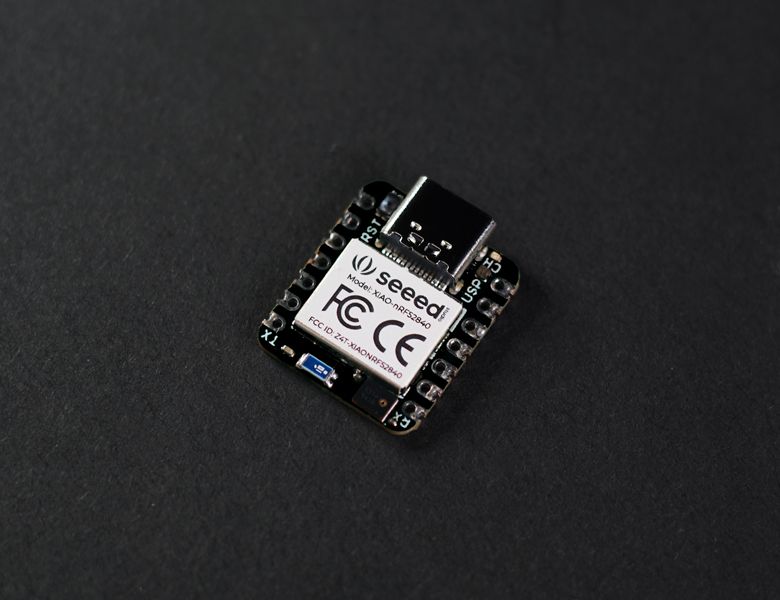
Seeed Studio XIAO nRF52840 (Sense) by Seeed Studio
Seeed Studio XIAO nRF52840 (Sense) has equipped a powerful Nordic nRF52840 MCU which is designed in a Bluetooth 5.0 module, built around 32-bit ARM® Cortex™-M4 CPU with Floating-Point Unit(FPU) operating at 64Mhz. With the capabilities of wireless connection, it still remains the Seeed Studio XIAO series classic form-factor of small and exquisite which can be used for wearable devices and Internet of Things projects. Furthermore, it only costs 5 μA in the deep sleep model and it supports battery charge management because of the BQ25101 chip.
In addition, the SENSE version of the board carries two extra onboard sensors. One of them is a digital microphone created through Pulse Density Modulation(PDM) module on the nRF52840 chip. It can receive audio data in real-time which allows it can be used for audio recognition. The board can receive audio data through the MSM261D3526H1CPM microphone. The other one is 6-axis Inertial Measurement Unit(IMU) which can be applied in TinyML projects like gesture recognition. These onboard sensors provide a great convenience for users and the ultra-small size feature of the board has still remained.
The same CircuitPython firmware can be used both for the Seed Studio XIAO nRF52840 with or without additional sensor.
Seeed Studio XIAO nRF52840 (Sense) contains a wealthy interface. The first thing to note is that the Near Field Communication(NFC) is functional on the board. Secondly, there is a tiny and elegant reset button on one side of the Type-C interface. On the other side, it is designed in a three-in-one LED along with a power LED. There are 11 digital i/o that can be used as PWM pins and 6 analog i/o that can be used as ADC pins. It supports UART, IIC, and SPI all three common serial ports. Same as Seeed Studio XIAO RP2040, it has an onboard 2 MB flash which means it can also be programmed by Arduino, MicroPython, CircuitPython, or other program languages.
- Bluetooth 5.0
- NFC
- 21 x 17.5mm tiny board
- 5 μA power consumption in deep sleep mode
- Battery Charging
- built-in 2 MB flash, microphone and 6-axis IMU
Purchase
- Seeed Studio SENSE version
- Seeed Studio version without sensor
Contribute
Have some info to add for this board? Edit the source for this page here.
CircuitPython 9.2.8
This is the latest stable release of CircuitPython that will work with the Seeed Studio XIAO nRF52840 (Sense). Use this release if you are new to CircuitPython.
On nRF boards, CircuitPython 8.2.0 and later require UF2 bootloader version 0.6.1 or later. Older bootloaders cannot load the firmware. See Update UF2 Bootloader below.
Modules included in this download
_asyncio _bleio _pixelmap adafruit_bus_device adafruit_pixelbuf aesio alarm analogio array atexit audiobusio audiocore audiomixer audiomp3 audiopwmio binascii bitbangio bitmapfilter bitmaptools board builtins builtins.pow3 busdisplay busio busio.SPI busio.UART codeop collections countio digitalio displayio epaperdisplay errno fontio fourwire framebufferio getpass gifio i2cdisplaybus io jpegio json keypad keypad.KeyMatrix keypad.Keys keypad.ShiftRegisterKeys keypad_demux keypad_demux.DemuxKeyMatrix locale math memorymap microcontroller msgpack neopixel_write nvm onewireio os os.getenv paralleldisplaybus pulseio pwmio rainbowio random re rgbmatrix rotaryio rtc sdcardio select sharpdisplay storage struct supervisor synthio sys terminalio tilepalettemapper time touchio traceback ulab usb_cdc usb_hid usb_midi vectorio warnings watchdog zlibFeatures: Bluetooth/BTLE, Breadboard-Friendly, Battery Charging, USB-C, Xiao / QTPy Form Factor, Castellated Pads
CircuitPython 10.0.0-alpha.8
This is the latest development release of CircuitPython that will work with the Seeed Studio XIAO nRF52840 (Sense).
Alpha development releases are early releases. They are unfinished, are likely to have bugs, and the features they provide may change. Beta releases may have some bugs and unfinished features, but should be suitable for many uses. A Release Candidate (rc) release is considered done and will become the next stable release, assuming no further issues are found.
Please try alpha, beta, and rc releases if you are able. Your testing is invaluable: it helps us uncover and find issues quickly.
On nRF boards, CircuitPython 8.2.0 and later require UF2 bootloader version 0.6.1 or later. Older bootloaders cannot load the firmware. See Update UF2 Bootloader below.
Release Notes for 10.0.0-alpha.8
Modules included in this download
_asyncio _bleio _bleio (native) _pixelmap adafruit_bus_device adafruit_pixelbuf aesio alarm analogio array atexit audiobusio audiocore audiomixer audiomp3 audiopwmio binascii bitbangio bitmapfilter bitmaptools board builtins builtins.pow3 busdisplay busio busio.SPI busio.UART codeop collections countio digitalio displayio epaperdisplay errno fontio fourwire framebufferio getpass gifio i2cdisplaybus io jpegio json keypad keypad.KeyMatrix keypad.Keys keypad.ShiftRegisterKeys keypad_demux keypad_demux.DemuxKeyMatrix locale lvfontio math memorymap microcontroller msgpack neopixel_write nvm onewireio os os.getenv paralleldisplaybus pulseio pwmio rainbowio random re rgbmatrix rotaryio rtc sdcardio select sharpdisplay storage struct supervisor synthio sys terminalio tilepalettemapper time touchio traceback ulab usb_cdc usb_hid usb_midi vectorio warnings watchdog zlibFeatures: Bluetooth/BTLE, Breadboard-Friendly, Battery Charging, USB-C, Xiao / QTPy Form Factor, Castellated Pads
Absolute Newest
Every time we commit new code to CircuitPython we automatically build binaries for each board and language. The binaries are stored on Amazon S3, organized by board, and then by language. These releases are even newer than the development release listed above. Try them if you want the absolute latest and are feeling daring or want to see if a problem has been fixed.
Previous Versions of CircuitPython
All previous releases of CircuitPython are available for download from Amazon S3 through the button below. For very old releases, look in the OLD/ folder for each board. Release notes for each release are available at GitHub button below.
Older releases are useful for testing if you something appears to be broken in a newer release but used to work, or if you have older code that depends on features only available in an older release. Otherwise we recommend using the latest stable release.
